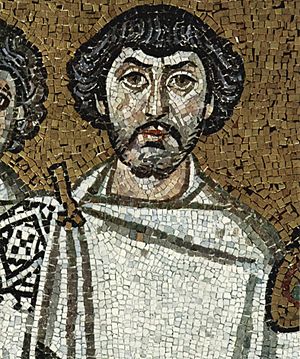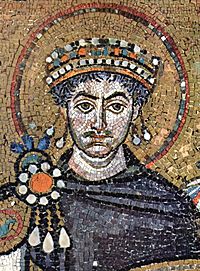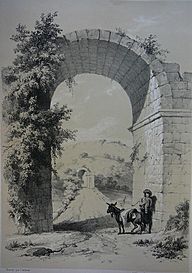Procopius facts for kids
Quick facts for kids
Procopius
|
|
|---|---|
| Born | c. 500 CE Caesarea Maritima, Palaestina Prima, Eastern Roman Empire |
| Died | c. 565 CE |
| Occupation | Legal adviser |
| Subject | Secular history |
| Notable works |
|
Procopius of Caesarea (Greek: Προκόπιος ὁ Καισαρεύς Prokópios ho Kaisareús; Latin: Procopius Caesariensis; c. 500 – 565) was a prominent late antique Greek scholar from Caesarea Maritima. Accompanying the Roman general Belisarius in Emperor Justinian's wars, Procopius became the principal Roman historian of the 6th century, writing the History of the Wars, the Buildings, and the Secret History.
Contents
Life
Apart from his own writings the main source for Procopius's life was an entry in the Suda, a Byzantine Greek encyclopaedia written sometime after 975 which discusses his early life. He was a native of Caesarea in the province of Palaestina Prima. He would have received a conventional upper class education in the Greek classics and rhetoric, perhaps at the famous school at Gaza. He may have attended law school, possibly at Berytus (present-day Beirut) or Constantinople (now Istanbul), and became a lawyer (rhetor). He evidently knew Latin, as was natural for a man with legal training. In 527, the first year of the reign of the emperor Justinian I, he became the legal adviser (adsessor) for Belisarius, a general whom Justinian made his chief military commander in a great attempt to restore control over the lost western provinces of the empire.
Procopius was with Belisarius on the eastern front until the latter was defeated at the Battle of Callinicum in 531 and recalled to Constantinople. Procopius witnessed the Nika riots of January, 532, which Belisarius and his fellow general Mundus repressed with a massacre in the Hippodrome. In 533, he accompanied Belisarius on his victorious expedition against the Vandal kingdom in North Africa, took part in the capture of Carthage, and remained in Africa with Belisarius's successor Solomon the Eunuch when Belisarius returned east to the capital. Procopius recorded a few of the extreme weather events of 535–536, although these were presented as a backdrop to Byzantine military activities, such as a mutiny in and around Carthage. He rejoined Belisarius for his campaign against the Ostrogothic kingdom in Italy and experienced the Gothic siege of Rome that lasted a year and nine days, ending in mid-March 538. He witnessed Belisarius's entry into the Gothic capital, Ravenna, in 540. Both the Wars and the Secret History suggest that his relationship with Belisarius cooled thereafter. When Belisarius was sent back to Italy in 544 to cope with a renewal of the war with the Goths, now led by the able king Totila, Procopius appears to have no longer been on Belisarius's staff.
As magister militum, Belisarius was an "illustrious man" (Latin: vir illustris; Greek: ἰλλούστριος, illoústrios); being his adsessor, Procopius must therefore have had at least the rank of a "visible man" (vir spectabilis). He thus belonged to the mid-ranking group of the senatorial order (ordo senatorius). However, the Suda, which is usually well informed in such matters, also describes Procopius himself as one of the illustres. Should this information be correct, Procopius would have had a seat in Constantinople's senate, which was restricted to the illustres under Justinian. He also wrote that under Justinian's reign in 560, a major Christian church dedicated to the Virgin Mary was built on the site of the Temple Mount.
It is not certain when Procopius died. Many historians—including Howard-Johnson, Cameron, and Geoffrey Greatrex—date his death to 554, but there was an urban prefect of Constantinople (praefectus urbi Constantinopolitanae) called Procopius in 562. In that year, Belisarius was implicated in a conspiracy and was brought before this urban prefect.
In fact, some scholars have argued that Procopius died at least a few years after 565 as he unequivocally states in the beginning of his Secret History that he planned to publish it after the death of Justinian. However, most scholars believe that the Secret History was written in 550 and remained unpublished during Procopius' lifetime.
Writings
The writings of Procopius are the primary source of information for the rule of the emperor Justinian I. Procopius was the author of a history in eight books on the wars prosecuted by Justinian, a panegyric on the emperor's public works projects throughout the empire, and a book known as the Secret History that claims to report the scandals that Procopius could not include in his officially sanctioned history for fear of angering the emperor, his wife, Belisarius, and the general's wife and had to wait until all of them were dead to avoid retaliation.
History of the Wars
Procopius's Wars or History of the Wars (Greek: Ὑπὲρ τῶν Πολέμων Λόγοι, Hypèr tōn Polémon Lógoi, "Words on the Wars"; Latin: De Bellis, "On the Wars") is his most important work, although less well known than the Secret History. The first seven books seem to have been largely completed by 545 and may have been published as a unit. They were, however, updated to mid-century before publication, with the latest mentioned event occurring in early 551. The eighth and final book brings the history to 553.
The first two books—often known as The Persian War (Latin: De Bello Persico)—deal with the conflict between the Romans and Sassanid Persia in Mesopotamia, Syria, Armenia, Lazica, and Iberia (present-day Georgia). It details the campaigns of the Sassanid shah Kavadh I, the 532 'Nika' revolt, the war by Kavadh's successor Khosrau I in 540, his destruction of Antioch and deportation of its inhabitants to Mesopotamia, and the great plague that devastated the empire from 542. The Persian War also covers the early career of Procopius's patron Belisarius in some detail.
The Wars’ next two books—known as The Vandal War or Vandalic War (Latin: De Bello Vandalico)—cover Belisarius's successful campaign against the Vandal kingdom that had occupied Rome's provinces in northwest Africa for the last century.
The final four books—known as The Gothic War (Latin: De Bello Gothico)—cover the Italian campaigns by Belisarius and others against the Ostrogoths. Procopius includes accounts of the 1st and 2nd sieges of Naples and the 1st, 2nd, and 3rd sieges of Rome. He also includes an account of the rise of the Franks (see Arborychoi). The last book describes the eunuch Narses's successful conclusion of the Italian campaign and includes some coverage of campaigns along the empire's eastern borders as well.
The Wars proved influential on later Byzantine historiography. In the 570s Agathias wrote Histories, a continuation of Procopius's work in a similar style.
Secret History

Procopius's now famous Anecdota, also known as Secret History (Greek: Ἀπόκρυφη Ἱστορία, Apókryphe Historía; Latin: Historia Arcana), was discovered centuries later at the Vatican Library in Rome and published in Lyon by Niccolò Alamanni in 1623. Its existence was already known from the Suda, which referred to it as Procopius's "unpublished works" containing "comedy" and "invective" of Justinian, Theodora, Belisarius and Antonina. The Secret History covers roughly the same years as the first seven books of The History of the Wars and appears to have been written after they were published. Current consensus generally dates it to 550, or less commonly 558.
In the eyes of many scholars, the Secret History reveals an author who had become deeply disillusioned with Emperor Justinian, his wife Theodora, the general Belisarius, and his wife Antonina. The work claims to expose the secret springs of their public actions, as well as the private lives of the emperor and his entourage. Justinian is portrayed as cruel, venal, prodigal, and incompetent. Similarly, the Theodora of the Secret History is a garish portrait of vulgarity juxtaposed with cold-blooded self-interest, shrewishness, and envious and fearful mean-spiritedness.
Furthermore, Secret History portrays Belisarius as a weak man completely emasculated by his wife, Antonina, who is portrayed in very similar terms to Theodora. They are both said to be former actresses and close friends. Procopius claimed Antonina worked as an agent for Theodora against Belisarius, and had an ongoing affair with Belisarius' godson, Theodosius.
On the other hand, it has been argued that Procopius prepared the Secret History as an exaggerated document out of fear that a conspiracy might overthrow Justinian's regime, which—as a kind of court historian—might be reckoned to include him. The unpublished manuscript would then have been a kind of insurance, which could be offered to the new ruler as a way to avoid execution or exile after the coup. If this hypothesis were correct, the Secret History would not be proof that Procopius hated Justinian or Theodora.
The Buildings
The Buildings (Greek: Περὶ Κτισμάτων, Perì Ktismáton; Latin: De Aedificiis, "On Buildings") is a panegyric on Justinian's public works projects throughout the empire. The first book may date to before the collapse of the first dome of Hagia Sophia in 557, but some scholars think that it is possible that the work postdates the building of the bridge over the Sangarius in the late 550s. Historians consider Buildings to be an incomplete work due to evidence of the surviving version being a draft with two possible redactions.
Buildings was likely written at Justinian's behest, and it is doubtful that its sentiments expressed are sincere. It tells us nothing further about Belisarius, and it takes a sharply different attitude towards Justinian. He is presented as an idealised Christian emperor who built churches for the glory of God and defenses for the safety of his subjects. He is depicted showing particular concern for the water supply, building new aqueducts and restoring those that had fallen into disuse. Theodora, who was dead when this panegyric was written, is mentioned only briefly, but Procopius's praise of her beauty is fulsome.
Due to the panegyrical nature of Procopius's Buildings, historians have discovered several discrepancies between claims made by Procopius and accounts in other primary sources. A prime example is Procopius's starting the reign of Justinian in 518, which was actually the start of the reign of his uncle and predecessor Justin I. By treating the uncle's reign as part of his nephew's, Procopius was able to credit Justinian with buildings erected or begun under Justin's administration. Such works include renovation of the walls of Edessa after its 525 flood and consecration of several churches in the region. Similarly, Procopius falsely credits Justinian for the extensive refortification of the cities of Tomis and Histria in Scythia Minor. This had actually been carried out under Anastasius I, who reigned before Justin.
Style
Procopius belongs to the school of late antique historians who continued the traditions of the Second Sophistic. They wrote in Attic Greek. Their models were Herodotus, Polybius and in particular Thucydides. Their subject matter was secular history. They avoided vocabulary unknown to Attic Greek and inserted an explanation when they had to use contemporary words. Thus Procopius includes glosses of monks ("the most temperate of Christians") and churches (as equivalent to a "temple" or "shrine"), since monasticism was unknown to the ancient Athenians and their ekklesía had been a popular assembly.
The secular historians eschewed the history of the Christian church. Ecclesiastical history was left to a separate genre after Eusebius. However, Cameron has argued convincingly that Procopius's works reflect the tensions between the classical and Christian models of history in 6th-century Constantinople. This is supported by Whitby's analysis of Procopius's depiction of the capital and its cathedral in comparison to contemporary pagan panegyrics. Procopius can be seen as depicting Justinian as essentially God's vicegerent, making the case for buildings being a primarily religious panegyric. Procopius indicates that he planned to write an ecclesiastical history himself and, if he had, he would probably have followed the rules of that genre. As far as known, however, such an ecclesiastical history was never written.
Some historians have criticized Propocius's description of some barbarians, for example, he dehumanized the unfamiliar Moors as "not even properly human". This was however, inline with Byzantine ethnographic practice in late antiquity.
Legacy
A number of historical novels based on Procopius's works (along with other sources) have been written. Count Belisarius was written by poet and novelist Robert Graves in 1938. Procopius himself appears as a minor character in Felix Dahn's A Struggle for Rome and in L. Sprague de Camp's alternate history novel Lest Darkness Fall. The novel's main character, archaeologist Martin Padway, derives most of his knowledge of historical events from the Secret History.
The narrator in Herman Melville's novel Moby-Dick cites Procopius's description of a captured sea monster as evidence of the narrative's feasibility.
List of selected works
- J. Haury, ed. (1962–64) (in el). Procopii Caesariensis opera omnia. revised by G. Wirth. Leipzig: Teubner. https://www.google.com/books/edition/Procopii_Caesariensis_Opera_Omnia/66ECMwEACAAJ?hl=en. "4 volumes"
- H. B. Dewing, ed. (1914–40). Procopius. Loeb Classical Library. Cambridge, Mass.: Harvard University Press and London, Hutchinson. "7 volumes, Greek text and English translation"
- Downey, G., ed. (1940) (in en). Buildings of Justinian. Loeb Classical Library. Cambridge, MA: Harvard University Press.
- G. A. Williamson, ed. (2007). Procopius | The Secret History. Loeb Classical Library. Harmondsworth: Penguin Books. ISBN 978-0140455281. "A readable and accessible English translation of the Anecdota"
- Prokopios | The Secret History. Indianapolis: Hackett Publishing. 2010. ISBN 978-1603841801. "This edition includes related texts, an introductory essay, notes, maps, a timeline, a guide to the main sources from the period and a guide to scholarship in English. The translator uses blunt and precise English prose in order to adhere to the style of the original text."
See also
 In Spanish: Procopio de Cesarea para niños
In Spanish: Procopio de Cesarea para niños



